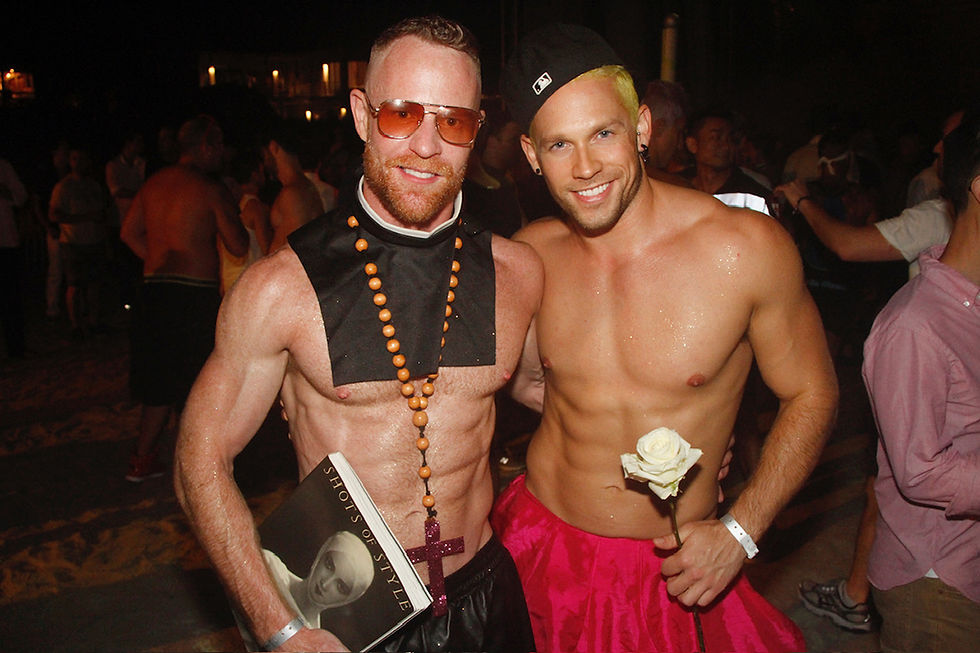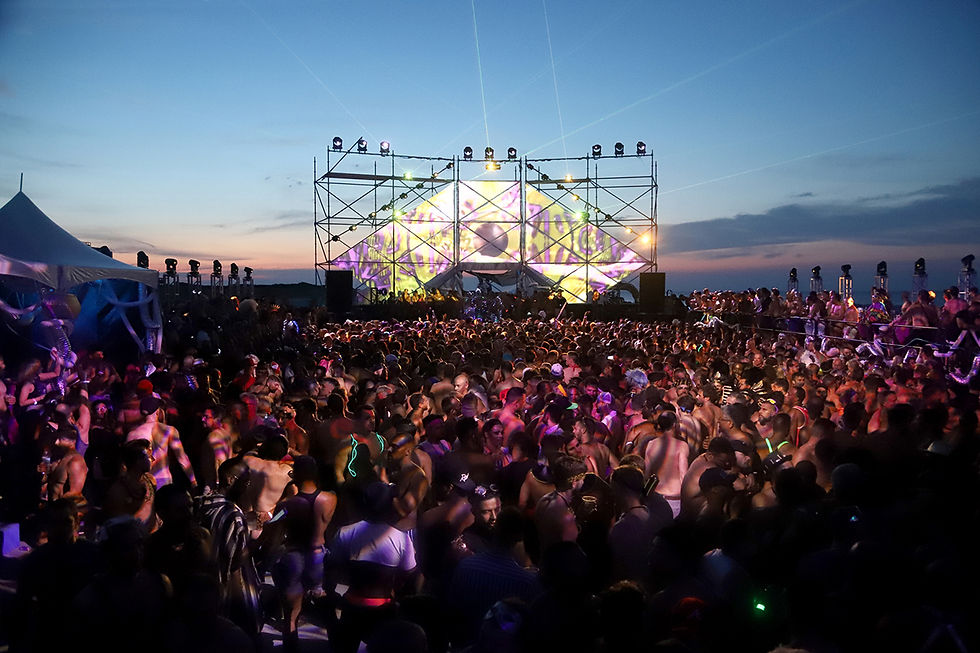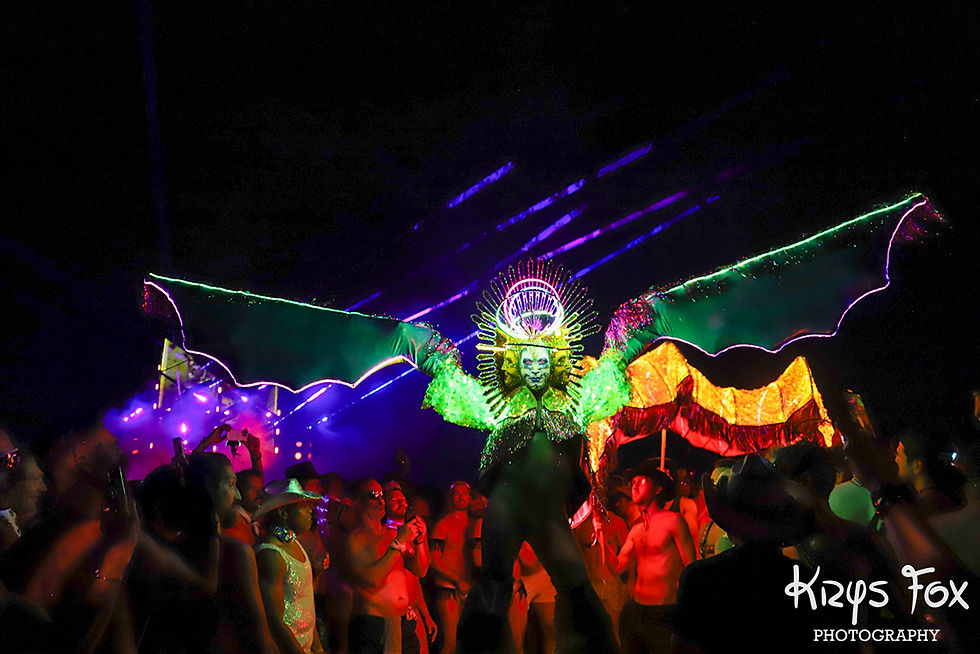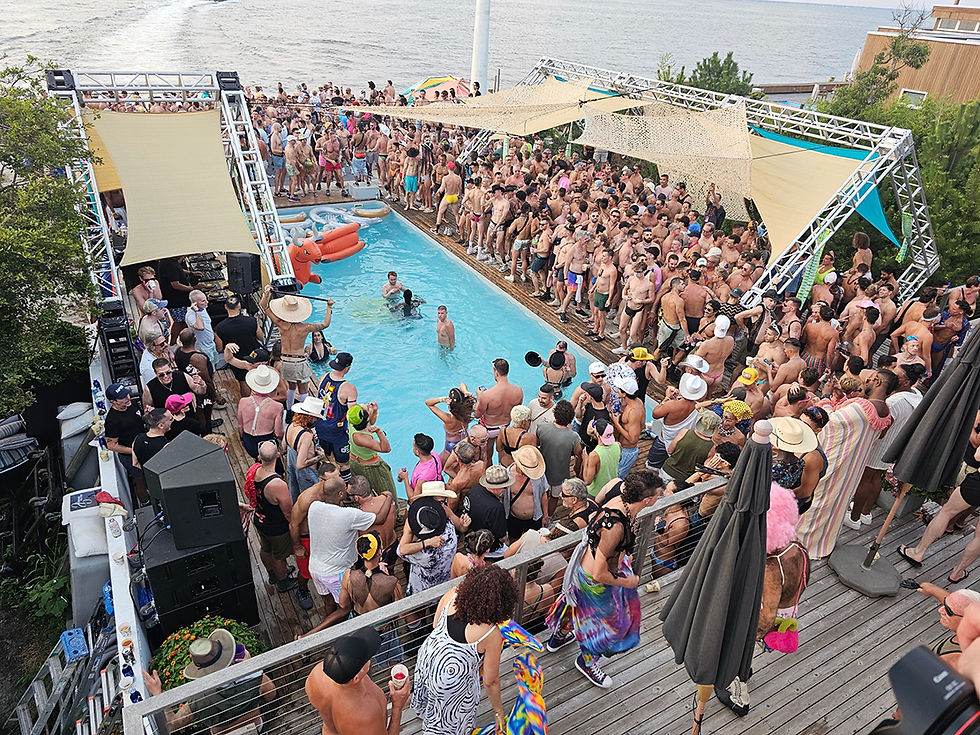The Legendary Pines Party | Fire Island's Gift To The LGBTQ+ Community
- anthony61845
- Aug 1
- 7 min read

Every summer, as the sun dips into the horizon over Fire Island, a magnetic energy begins to build. It crackles through the Pines like a warm electric current, summoning people from around the globe for what has become one of the most iconic LGBTQ+ events in the United States: Pines Party. Equal parts fantasy, freedom, and philanthropy, this legendary celebration is far more than a beachside rave—it is a movement, a memory, and a mission all in one.
Set against the stunning backdrop of Fire Island Pines, the Pines Party is a transcendent 24-hour journey that merges high-concept production, unforgettable music, and inclusive community spirit into one unforgettable experience. But beyond the strobe lights and glitter lies something deeper: a tradition rooted in the LGBTQ+ community's resilience, creativity, and commitment to collective care.

Fire Island as a destination has always been a safe haven for the LGBTQ+ community, and, over the years, has stayed true to its form - but added a few things here and there. This year, Fire Island Pines welcomed the beginning of the new Tryst Hotel, a LGBTQ+-focused upscale hotel brand that broke ground and will fully open in 2026. The pool, which is open this season, will host the pool party happening on Saturday, August 2nd.
To understand the magic of Pines Party, one must return to its origin. It all began in 1983 when GMHC (Gay Men’s Health Crisis) launched a daytime beach party on Fire Island to raise funds for a mysterious and devastating disease that would later be named HIV/AIDS. Dubbed the "Morning Party", the event gained momentum for 16 years, becoming a beacon of unity and a lifeline for a community under siege. It was a place where queer New Yorkers, specifically, came to do something about an illness overtaking their community. But by 1999, GMHC stepped away from organizing the event. Rather than let the tradition fade, the local community took the reins and reimagined it as the Pines Party—a continuation of the celebration, with a renewed sense of purpose and local stewardship.
Enter Guy Smith and Allan Baum, who inherited a waning event and transformed it into a global phenomenon. “That first party I worked on was the 20th anniversary of the very first beach party ever held out here—Beach 79,” Guy recalls. “That legacy of fundraising has always been part of the DNA.” And, over the years, it has never wavered from making that the root of the party's mission.

In an exclusive conversation, Inspired Citizen founder Anthony Berklich sat down with the Pines Party team to dive into its evolution, meaning, and vision.
AB: Guy, can you take us back to the very beginning? How and why did the Pines Party first start, and what was the original vision behind creating such a legendary event on Fire Island?
GS: Well, I didn’t create it—Allan Baum and I took it over 11 years ago. At that point, the party had become stale and was losing money. It wasn’t really aligned with what people were interested in anymore. It originally began in 1983 as a daytime party by GMHC, to raise money for a relatively new and devastating disease—what would eventually be called AIDS. It became known as the Morning Party and ran for 16 years.
In 1999, when GMHC stopped supporting it, the people of Fire Island Pines took over to keep it going and raise more money locally. That’s when it became the Pines Party. I started out as a volunteer, and soon after, I was directing the light show for the night. That first party I worked on was the 20th anniversary of the very first beach party ever held out here—Beach 79—which raised funds for a new fire truck. That legacy of fundraising has always been part of the DNA.

AB: Over the years, Pines Party has grown into more than just a celebration. What do you think it symbolizes today for the LGBTQ+ community, and how has its meaning evolved?
GS: Fire Island is a spiritual and deeply community-centered place. It’s always been a safe haven—especially for people who are queer, trans, or anyone who doesn’t fit into any traditional norms. The Pines Party has become the spiritual nexus of this community. It’s sort of our version of church. It’s about community, spirituality, vulnerability, and celebrating our differences. We’ve moved far from the early days when everyone tried to look like the same “gay clone”. Now, it’s about individuality and inclusion. The party has become much more queer in its identity—it’s not about masculinity and class and assimilation anymore. It embraces trans people, people of color, and others who’ve historically felt left out.
AB: Have you noticed any meaningful changes in the way Pines Party has evolved since its inception?
GS: Absolutely. It started during the birth of the circuit party scene. In those days, circuit parties were about raising money for HIV/AIDS, but also about a certain style—masculine gay energy and a specific kind of music. As we moved out of the worst of the AIDS crisis, and with the introduction of retroviral drugs, the culture began to shift. Today, our music is more world-class house and less circuit-identified. There’s much more diversity now—more trans folks, more people of color. We’re actively working to create a larger tent that welcomes those who might not have felt included here before.

AB: Many see Pines Party as a cultural touchstone within queer nightlife. How do you see it contributing to or preserving LGBTQ+ history and expression?
GS: Fire Island is a very intergenerational space. At Pines Party, you’ll find people aged 21 to 91—and importantly, those age groups mix. Older people learn new ideas from the younger crowd, and the younger attendees learn our queer history directly from those who lived it. It’s a place where young queer people can feel safe and vulnerable—where they can expand their social wisdom and connect with the roots of our culture from people who pioneered it.
AB: Fire Island itself has a rich legacy as a sanctuary for queer identity and freedom. How do you ensure that the party stays true to that spirit while continuing to innovate?
GS: We’re leaning into queer, BIPOC, non-binary DJs and artists with unique musical perspectives who reflect our community and where it is moving. We’re always pushing to be on the cutting edge—musically and culturally, and want fresh perspectives and cultural diversity to enrich the amazing culture that already thrives here.
We also use social media and other outreach to make it clear that this is a welcoming, non-judgmental, inclusive space. We don’t discriminate based on background, sexuality, gender identity, or finances—even though, admittedly, it is expensive just to exist here.
We try to make it as accessible as possible, while still raising money for the very communities we want to include.

AB: The party is not only iconic—it’s also philanthropic. How does it give back to the local community and support LGBTQ+ causes?
GS: One of our biggest beneficiaries is the Stonewall Community Foundation, which does tremendous work in the LGBTQ+ community. I just attended their gala and was really inspired by the breadth of important, on-the-ground work they are doing. We also support beach conservation and the broader preservation of the Pines as a natural sanctuary.
Most importantly, the people who build this event—our committees and crews—are mostly volunteers. This isn’t a for-profit event. The few people who do get paid aren’t making nearly what they’re worth. It’s truly a labor of love.
AB: As the cultural and political landscape shifts, how do you see Pines Party evolving over the next 5 to 10 years? Are there specific goals shaping its future?
GS: We want to stay at the forefront of music, fashion, and culture. That means continuing to explore themes that make people think—and sometimes make them uncomfortable in a way that promotes growth. We’re actively exploring how to better welcome people of color and others who have been historically excluded. That includes making room for more voices and perspectives in how the party evolves.

AB: Without giving too much away, can you hint at what guests can expect from Pines Party 2025? Any big surprises or creative elements?
GS: This year will have the most art installations and interactive experiences we’ve ever done. It’s going to feel like a mini queer Burning Man on the beach. Look in corners, behind curtains—there will be hidden moments everywhere. And definitely don’t leave early. We have a majestic sunrise performance planned that’s going to be unforgettable.
AB: Of all the years you’ve been involved with Pines Party, is there one moment that truly encapsulates the spirit of the event for you?
GS: One of the most unforgettable moments was my very first year producing. At sunrise, as the music faded, people began to leave. The tradition was that a board member took the microphone and thanked everyone involved, but instead—something magical happened.
A massive, beautiful man walked into the ocean, lifted a mermaid off the sand, and carried her to the stage. He lay her down on a red velvet divan, and suddenly orchestral music began. Then she sang—an opera singer from the Met, performing Song to the Moon in Czech. The crowd stopped. People cried. And I thought, This is it. This is what we’re capable of.

The Pines Party is a convergence of thousands—from New York to São Paulo, Berlin to Bangkok—all arriving with open hearts, ready to connect, celebrate, and give back. Tickets may grant access to an unforgettable night, but what guests really receive is a sense of home. A celebration of queerness in all its glory. A fundraising engine for progress. A mirror of our past and a vision for our future.
As the waves crash and the sun rises over Fire Island, the Pines Party remains what it has always been: a sacred space where art, identity, and community intersect. And in that golden hour, when music meets memory, the world feels more open, more loving, and freer. For anyone who believes in the power of celebration as resistance and love as legacy, Pines Party is not just an event—it’s a pilgrimage.


Comments